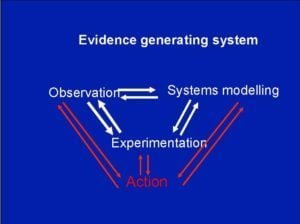Making Methods Work For and Inform Each Other: Ana Diez Roux on Health Disparities Research
Christine BachrachReducing health disparities and achieving health equity are core goals of population health research. Because disparities are the product of so many factors, at so many levels of organization, interacting in complex ways, health disparities provide an excellent frame for explaining why population health research needs to rely on a suite of powerful methods.
This was the message from incoming IAPHS President Ana Diez Roux at the inaugural lecture of the National Institute on Minority Health and Health Disparities Director’s Lecture Series on December 7, 2017. Ana’s talk was a richly detailed exploration of the ways we study health disparities, the issues surrounding them, and their essential complementarity. (Readers can view the entire talk at here.)
Why is studying health disparities so challenging?

Disparities are the outcome of multiple causes, operating at multiple levels in multiple domains: for example, genetic causes, health care, behaviors, economic conditions, policies, and more. The causal pathways producing disparities interact with one another, differ in the time and space over which effects occur, and may change depending on the context in which they play out. Effects are often bi-directional, generating feedback loops in the overall system and emergent patterns that are not easily reducible to “independent effects.”
The challenges for scientists, given this reality, are manifold. Scientists must identify the causal pathways (causes, mediators) and mechanisms that lead to disparities in specific outcomes. They must study the conditions under which different pathways are relevant and the ways in which effects ripple through the system. They must also identify specific ways to intervene in this complex system under various conditions to reduce disparities, and find out whether these interventions work.
A key point in the Diez Roux talk was the need for population health researchers to adopt multiple methodologies, and allow each to inform the others, to make progress in addressing health disparities.
Three (four) essential scientific approaches
Diez Roux focused mainly on three essential scientific approaches to studying disparities: experimentation, observation, and systems modeling. She also emphasized a fourth – description – which provides a critical foundation by uncovering what disparities exist, to what extent, and under what conditions. Description is essential for framing research questions and hypotheses.
Experimental approaches
Experimental methods are widely viewed as the gold standard for establishing causal effects, and are the method of choice when a well-defined, actionable intervention with randomized assignment is possible. However, in the context of population health research, reliance on Randomized Controlled Trials (RCTs) often poses problems. RCTs are not feasible or ethical when studying the effects of many of the social determinants of health; they may not be able to capture causal effects that occur over extended periods of time; their results may vary depending on the setting and circumstances of the experiment; and they cannot explain the mechanisms that produced the results of the trial.
This means that experimental studies have an essential, but non-exclusive, place in the toolkit of approaches to studying health disparities. When it comes to evaluating whether specific interventions will produce the expected outcomes when implemented under specific circumstances, there is no equivalent substitute.
Observational studies
Observational approaches are essential for filling out knowledge about the mechanisms and pathways that produce health disparities. The Achilles heel of observational studies is that they reveal associations, and not causal relationships, limiting their ability to inform interventions. Observational methods vary widely in the extent to which they overcome this problem. For example, natural experiments (for example, studying the effects of a policy that is implemented at different times in similar states) can give useful leverage in demonstrating causality. Methods developed by epidemiologists allow estimation of causal effects when treatments and counterfactuals can be crisply defined. Econometric techniques for estimating causal effects have also been available for some time. All of these methods, when feasible, are valuable additions to the toolkit for studying health disparities, and there is much room for continued innovation and discovery to expand and improve them.
But observational studies can be informative even when there is no focus on drawing causal conclusions, and in many cases they are the only viable approach to learning about the distal and/or macro causes of disparities. Well-conducted observational studies can provide useful evidence by uncovering and carefully analyzing relationships among factors across many different levels. This can lead to the formation of hypotheses or the identification of specific treatments that can be further studied.
Systems approaches
Systems approaches are a final essential element of the toolkit for health disparities research. Systems modeling provides a way of integrating, in a formal model, available knowledge about the key determinants of a specific disparity and the causal pathways linking them. The resulting model can be used to simulate and explore the functioning of the overall system. Systems models open the door to new questions about health disparities: for example, instead of asking, “Is neighborhood segregation associated with health independent of SES,” one might ask, “To what extent (and under what conditions) could residential segregation generate, and reinforce, health disparities by race?”
These models can be used to study interventions that are not yet feasible in the real world under varying conditions, identify “new” points of intervention, and identify and understand reasons for unexpected effects. However, the models depend on having a significant body of knowledge about causal pathways and their interrelationships; hence they too cannot stand alone.
Making methods work for each other to inform health disparities
In her talk, Diez Roux illustrated how each approach can inform the other: observational studies by helping to build knowledge about the broad system of determinants and identifying potential points of intervention; experimental methods by producing evidence of causal effects and feeding back that knowledge for refinement of etiological studies; and systems modeling by demonstrating the implications of causal knowledge for the overall operation of the system and potential interventions. When taken together, these different approaches will do a better job of informing action than any one approach alone.






Guest Blog Post: Interdisciplinary Association for Population Health Science | NIMHD Insights Blog
August 30, 2018 @ 7:41 am
[…] Population Research Center at the University of Maryland, College Park. View the IAPHS post, Making Methods Work for and Inform Each Other: Ana Diez Roux on Health Disparities Research, […]